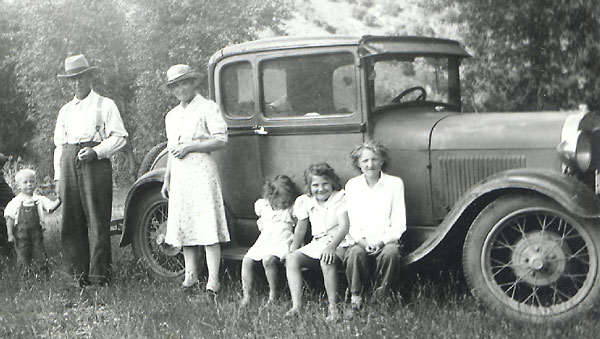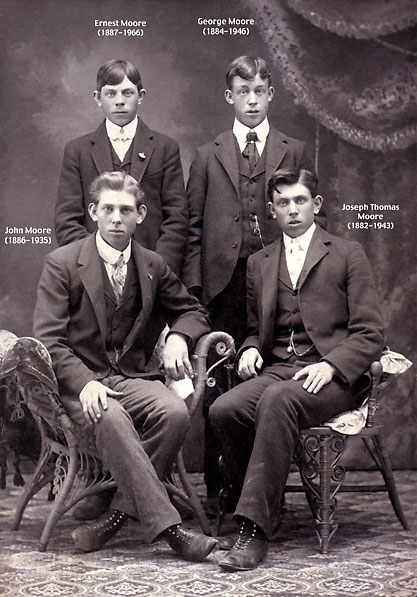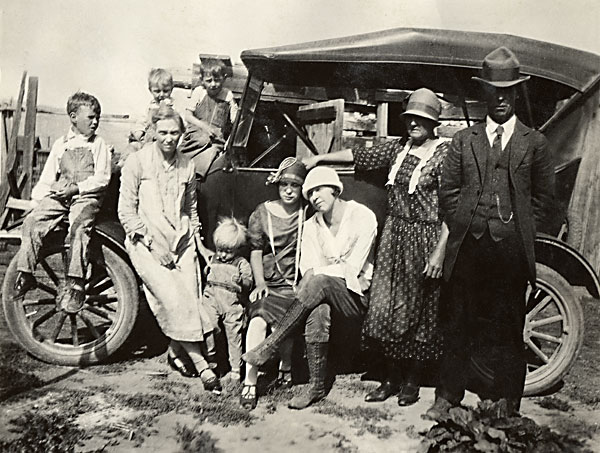 |
||
|
Nora Ryset was the oldest child of Frank and Priscilla Ryset
|
|||
|
The adults in the picture above are George Moore and Nora Ryset Moore. Nora was born in 1889, married George Moore 10 April
1907, and died in 1964.
Nora Ryset Moore Four Generations Click on the link above to be taken to a page with four generation pictures of Nora Ryset Moore with her mother, grandmother, daughter and granddaughter.
In the picture above is George Moore and three of his brothers. George Moore married Nora Ryset. Life sketch for George Moore and Nora Ryset Moore Written by LaVerne Moore Johnson July, 1981 George Moore, the second child of John Thomas and Annie Andersen Moore, was born in Spanish Fork, Utah, March 25, 1984. His childhood was spent in Spanish Fork Canyon, and he attended the Clinton Elementary School, five miles south of Thistle Junction, with his brothers Tom, John, and Ernest. He never had much to say about his early life. One prank he used to tell about was how he and some of the boys, probably his brothers and a few schoolmates would spread wagon grease on the railroad rails at the steepest part of the grade as the train crossed the summit to go to Denver. As the engine reached the slick track, it would lose traction and begin sliding backwards. The engineer would then have to release sand from the two sand boxes located just above and slightly in front of the drive wheels of the engine. This would delight the boys who were well hidden nearby watching the stalling of the train and the gaining of momentum as sand was poured on the rails. They realized this was a dangerous thing to do since it could cause a derailment, but they were lucky and no accidents occurred nor were the mischief-makers discovered in their pranks. He also liked to tell how Tom fell in the creek. There was an old pole tree across the creek near their home. Tom was playing by the creek and decided he wanted to go on the other side for something and proceeded to walk the pole. He got well out in the middle when he slipped and fell in the water. The water was low enough that he was able to wade out and go dripping to the house to his mother. When she asked him how he fell in the creek, he looked at her with his big blue eyes and said, "Easy." Life wasn't easy for the Moore family in Spanish Fork Canyon. They learned that living conditions were better and there was more opportunity to get ahead in the Upper Snake River Valley in Idaho where John T.'s brother, Willard, was living. After a visit with Willard in the spring of 1897, John T. decided to move his family to Idaho. They moved in wagons bringing everything they owned with them. They arrived at Shelton, (then Prospect) October 30,1897 and settled on a farm near Willow Creek, where they lived the rest of their lives. George was then 13 years old. When he left Spanish Fork, he never returned even for a short visit. He said, "I never left anything there, so I have nothing to go back for."
George Moore portrait extracted from a large John Thomas and Annie Andersen Moore family group picture. He continued his schooling at Shelton. He was a good student. He excelled in mathematics and was an excellent penman. However he never had the opportunity to go beyond the eighth grade. Most of the time he worked on the farm helping his father, but there was at least one year that he worked for David Ririe, who later became the first bishop of Ririe Ward and for whom the town of Ririe was named. It was about this time that he became interested in a vivacious blue-eyed girl with light brown hair and decided that Nora Ryset, the daughter of Frank and Priscilla Morgan Ryset, was the only one for him. The courtship of these two was a very private matter. They never talked about it. In April 1907, George Moore and Nora Ryset, Ernest Moore and Viola Cole, Robert and Deloris Morgan, and Willard and Annie Moore traveled to Salt Lake City where George and Nora and Ernest and Viola went to the house of the Lord, on April 10, 1907, and were married for time and all eternity. After they returned home they each homesteaded one hundred sixty acres of land just east of their father's land. These farms were on the foothills south of the Shelton Cemetery. Ernest's land was a quarter of a mile south and George's was one half a mile south. Ernest and Viola were the first to build their little one room house. George and Nora built a dug-out room which they lived in the first few years of their marriage. It was while they were still living in this tiny dug-out that a baby boy, named John Francis, was born to them. This baby was born two months prematurely and only lived from October 31, 1908 to November 5, 1908. There was sorrow and disappointment in that humble home. They continued to clear the land and do the things required to 'prove up' on a homestead. A house similar to that of Ernest and Viola was built and they were living in it when a baby girl was born to them on September 8, 1910. She was named Nora Laverne. Although she, too, was tiny and not very strong with lots of love and tender care she was able to survive. A short time after this, John T. Moore realized that with his large family of boys he would need more land in order to provide each with a suitable home. So he purchased what was known as the Martin Place, one hundred sixty acres that lay between the Upper Shelton and the Shelton roads. This place was under irrigation and it was necessary to have someone there to be responsible for its upkeep. Dad and Mother moved into the two room log house and took that responsibility until the acreage was divided among the brothers when each became accountable for his own share. Twenty acres turned out to be too small a farm to be successful for any of them so some sold to others until only four, Wesley, Willard, John, and George were left on the Martin Place. Dad sold his twenty acres near the middle of the field to Willard and Wesley and acquired the east forty where he built a new four room house from lumber he salvaged from the old Shelton school house. Dad and Mother now had a comfortable home. They moved into it in the spring of 1923. They soon had a nice dairy herd, a good flock of chickens, and a few pigs. This provided them with a good living. Though they never attained great wealth, they never wanted for the necessities of life. There was always plenty to share with anyone in need. And share they often did! Although Dad was not very active in church attendance, he had a strong testimony of its truthfulness and always paid an honest tithe. He was generous with all civic as well as church donations. He was among those who helped build the new Shelton Church. Dad loved children. He spent hours playing with me and teaching me many practical things he knew would be of benefit to me later in life. He and Mother saw to it that I knew and understood the principles of the gospel and I was given a good education. He welcomed both Loran and Frank Marler, Mother's nephews, into his home when they were having difficulties in their own home and community. He tried to direct and teach them as if they were his own sons. The Moore family was very talented in dramatics and every winter for many years they presented one or two plays for the benefit of the Ward MIA. Dad sometimes took a part, but he preferred being prompter and assisting with production. These plays were presented in many of the wards in the area, and these wards in turn brought their productions back to Shelton. Thus good wholesome entertainment was provided throughout the long winter. During the late 1920's and early 1930's the country was stricken by a financial depression. Money was scarce. Dad found it necessary to seek employment at the Utah-Idaho Sugar Company in Lincoln, Idaho. He worked there for two seasons, but he decided the extra job was more than he could do and still care for his cattle and farm. When Dad was a child, he had rheumatic fever. He always thought it was because of this fever that he later had severe attacks of tonsilitis or quinsy every Winter. These attacks became less frequent and his health was good for a few years. He then began having trouble with his heart. His doctor told him he had a 'rheumatic heart.' When I married a young returned missionary named Rulon Johnson, Dad readily accepted him as part of the family. They spent many happy hours fishing, hunting, and working together. The four of us (Mother, Dad, Rulon, and I) often went on picnics and outings, and we celebrated most of the holidays together. It was a time of sorrow for all of us when my first child died at birth and my life, too, was almost lost. It was through the power of the priesthood that my life was saved. Three years later Rulon and I were blessed with another son who we named George Kent. Dad was elated to have his grandson bear his name. He again had someone dear he could love, teach, guide, and direct. Dad was unhappy when Rulon, Kent, and I moved to Vancouver, Washington about a year after the outbreak of World War II. We had only been there about a month when Rulon received an emergency phone call at work telling him that Dad was seriously ill in the hospital at Idaho Falls. He had been rushed to the hospital with bleeding ulcers and an operation was performed immediately. His condition was critical for several days. He slowly responded to treatment and in about three weeks he was able to go home where he convalesced for a long time. As the spring of 1943 approached, plans were made for Rulon and I to return to Idaho and run the farm for Dad and Mother.
This plan did not turn out well because the little farm and small dairy herd did not produce enough to support two families.
Dad and Mother sold their home they had lived in so long and bought a house in Idaho Falls. This house was on Lava Street.
They had only been there a short time when Dad was offered a janitor job at the high school in Lima, Montana, where Mother;s
sister Zella Ryset Marler lived. He thought he was well enough to do this work, so he sold the house on Lava Street and moved
to Montana. He and Mother had only been there a few weeks when he had a heart attack and had to be taken to the hospital
in Dillon, Montana. He was not hospitalized long, but he now realized he could not do the heavy lifting on that job.
They were now without a home, so they lived with us in Ririe, Idaho that winter. Mother kept house and tended Kent while I taught school. In the spring they bought a small apartment house on Water Avenue, in Idaho Falls. Mother found work at the L.D.S. Hospital and with her income and the income from the apartments they were to get by. It was the latter part of September 1946 when Dad took me aside and told me he was going to be operated on Wednesday morning. He said, "I can't go on this way. I have thought it over, and no matter which way it goes, it will be all right. I am ready." He withstood the surgery, but was in very poor condition. Mother and I remained at his bedside all day, all night, and the next day. That evening I went home to get some rest so I could relieve her the next morning. It was 1:00 P.M. Friday, September 27, 1946 that he passed away at the Idaho Falls L.D.S. Hospital, Idaho Falls, Idaho.
In the picture above are Nora Ryset Moore, Priscilla Morgan Ryset and George Moore. George is on the right and Priscilla is next to him. Nora is sitting on the fender. George and Nora Ryset Moore Headstone Click on the link above to see a picture of George and Nora's gravestones. |
|||



